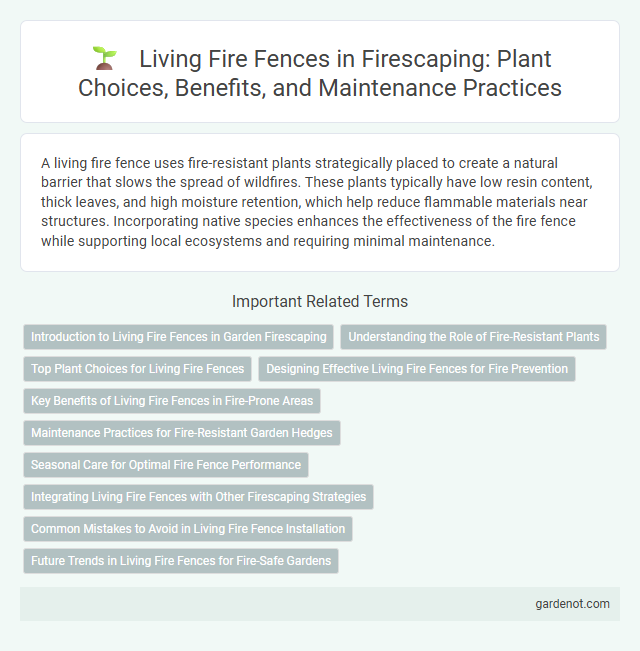A living fire fence uses fire-resistant plants strategically placed to create a natural barrier that slows the spread of wildfires. These plants typically have low resin content, thick leaves, and high moisture retention, which help reduce flammable materials near structures. Incorporating native species enhances the effectiveness of the fire fence while supporting local ecosystems and requiring minimal maintenance.
Introduction to Living Fire Fences in Garden Firescaping
Living fire fences integrate fire-resistant plants and natural barriers to create a protective boundary that reduces wildfire risk in garden firescaping. These green barriers use species such as aloe, agave, and other succulents that retain moisture and slow fire spread, enhancing landscape safety. Incorporating stone or gravel pathways within living fire fences further minimizes combustible materials, optimizing garden fire resilience.
Understanding the Role of Fire-Resistant Plants
Fire-resistant plants play a crucial role in creating a living fire fence by reducing the spread of wildfires through their low flammability and moisture-rich foliage. Species such as succulents, lavender, and oakleaf hydrangea can serve as natural barriers that slow down flames and protect structures. Incorporating these plants into strategic landscaping enhances fire safety while maintaining aesthetic and ecological benefits.
Top Plant Choices for Living Fire Fences
Top plant choices for living fire fences include fire-resistant species like manzanita, California lilac, and oleander, known for their low flammability and dense foliage. These plants create effective natural barriers that slow fire spread while withstanding harsh heat conditions. Incorporating drought-tolerant varieties such as succulents and lavender enhances fire resilience and reduces irrigation needs.
Designing Effective Living Fire Fences for Fire Prevention
Designing effective living fire fences involves selecting fire-resistant plant species with high moisture content and low resin levels to create a natural barrier that slows fire spread. Strategic placement of these plants in layered arrangements enhances their ability to block embers and heat, reducing wildfire impact on properties. Incorporating regular maintenance such as pruning and irrigation ensures the fence remains healthy and functional as a fire-preventive measure.
Key Benefits of Living Fire Fences in Fire-Prone Areas
Living fire fences serve as effective natural barriers by using fire-resistant plants that reduce fuel availability, thus slowing wildfire spread in fire-prone areas. These fences enhance property protection by creating defensible spaces that limit fire damage while fostering biodiversity and improving ecosystem resilience. Strategic placement of living fire fences can also improve air quality and soil stability, contributing to long-term environmental health.
Maintenance Practices for Fire-Resistant Garden Hedges
Fire-resistant garden hedges require regular pruning to remove dead or dry branches, reducing fuel for potential fires. Irrigation practices should ensure deep watering to maintain plant moisture levels, enhancing the hedge's natural fire resistance. Mulching with non-flammable materials further protects the root zone, minimizing fire spread risks around living fire fences.
Seasonal Care for Optimal Fire Fence Performance
Maintaining a living fire fence requires seasonal care to ensure maximum fire-resistant properties and healthy plant growth. Pruning dead or dry foliage in late winter reduces fuel load and enhances air circulation, lowering the risk of fire spread. Regular watering during dry summer months and mulching help sustain moisture levels, promoting resilient, verdant barriers against wildfires.
Integrating Living Fire Fences with Other Firescaping Strategies
Living fire fences enhance fire prevention by creating natural barriers that slow wildfire spread while complementing hardscape elements like gravel pathways and fire-resistant decking. Strategic placement of fire-resistant plants alongside these fences improves overall landscape resilience, reducing fuel connectivity and providing defensible space. Combining living fire fences with irrigation systems and regular maintenance ensures optimal plant health and maximizes wildfire protection.
Common Mistakes to Avoid in Living Fire Fence Installation
Incorrect plant selection, such as using species with low fire resistance or high flammability, undermines the effectiveness of a living fire fence. Overcrowding plants without proper spacing reduces airflow and increases fire risk, while failure to maintain adequate irrigation leads to dry vegetation that fuels wildfires. Avoiding these common mistakes ensures a living fire fence serves as a reliable firebreak and enhances property protection.
Future Trends in Living Fire Fences for Fire-Safe Gardens
Future trends in living fire fences emphasize the use of drought-tolerant, fire-resistant plant species such as manzanita, ceanothus, and sumac to create natural barriers that reduce fire spread. Innovations in irrigation technology and soil management enhance plant health and resilience during dry conditions, helping maintain continuous green firebreaks. Integration of smart monitoring systems allows homeowners to track moisture levels and plant stress, optimizing fire-safe garden maintenance.
Living fire fence Infographic

 gardenot.com
gardenot.com